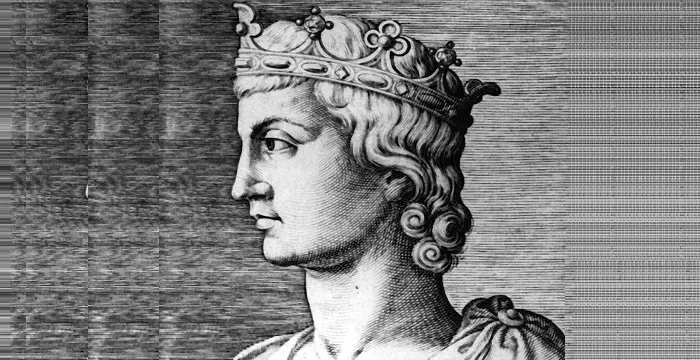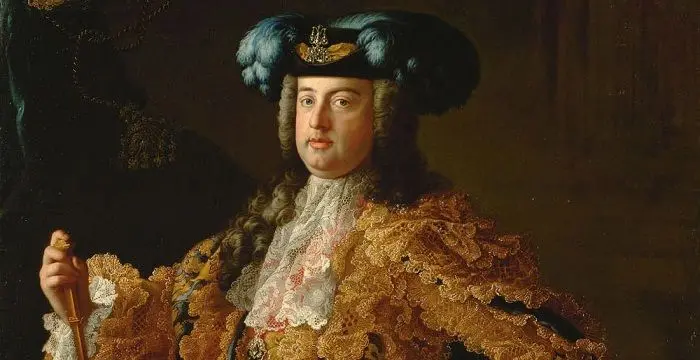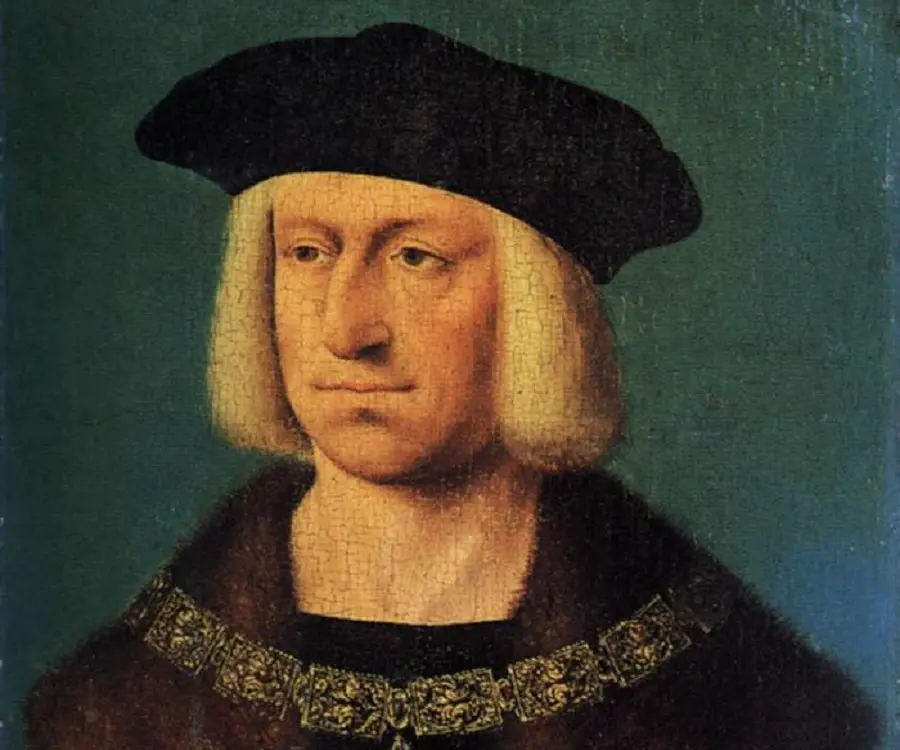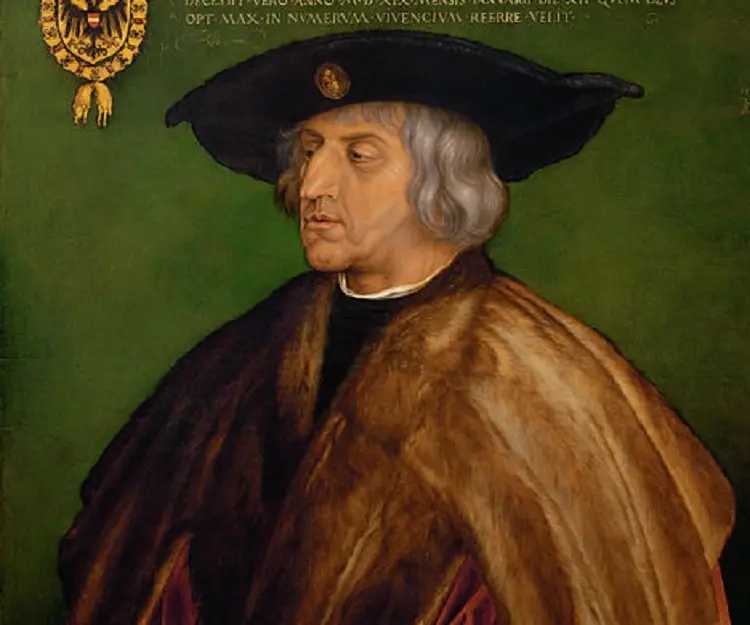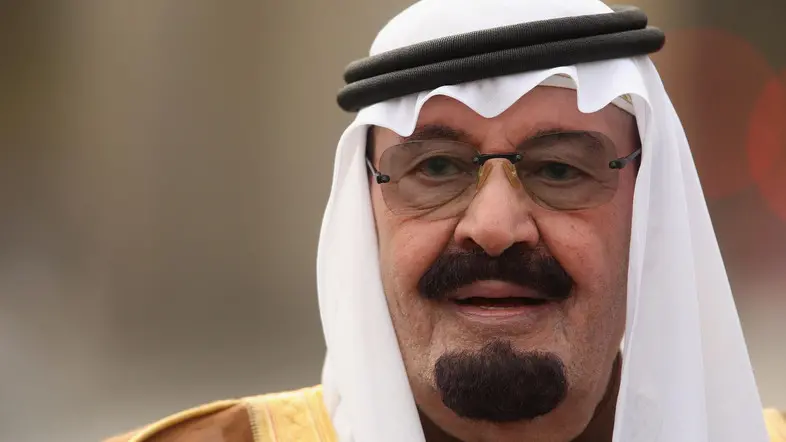
Maximilian I, Holy Roman Emperor - Holy Roman Emperor, Timeline and Childhood
Maximilian I, Holy Roman Emperor's Personal Details
Maximilian I was the King of Romans and first elected Holy Roman Emperor
| Information | Detail |
|---|---|
| Birthday | March 22, 1459 |
| Died on | January 12, 1519 |
| Nationality | Australian |
| Famous | Historical Personalities, Emperors & Kings, Emperors, Holy Roman Emperor, Kings |
| Spouses | Anne of Brittany, Bianca Maria Sforza, Mary of Burgundy |
| Siblings | Kunigunde of Austria |
| Known as | Holy Roman Emperor Maximilian I |
| Childrens | Philip I of Castile |
| Birth Place | Wiener Neustadt |
| Religion | Catholicism |
| Gender | Male |
| Father | Frederick III, Holy Roman Emperor |
| Mother | Eleanor of Portugal, Holy Roman Empress |
| Sun Sign | Aries |
| Born in | Wiener Neustadt |
| Famous as | Holy Roman Emperor |
| Died at Age | 59 |
// Famous Holy Roman Emperor
Frederick II, Holy Roman Emperor
Frederick II was a mighty Holy Roman Emperor of the Medieval Era. This biography profiles his childhood, life, reign, achievements and timeline.
Maximilian II, Holy Roman Emperor
Maximilian was the Holy Roman Emperor who served as the King of Germany, Bohemia, Hungary and Croatia. Check out this biography to know about his childhood, life, achievements, works & timeline
Francis I, Holy Roman Emperor
Francis I served as the Holy Roman Emperor and Grand Duke of Tuscany from 1740s until his death in 1765. Check out this biography to know about his childhood, life, achievements, works & timeline
Maximilian I, Holy Roman Emperor's photo
Who is Maximilian I, Holy Roman Emperor?
Maximilian I was the King of Romans who served as the Holy Roman Emperor from 1508 until his death in 1519. He was the first to be the Elected Roman Emperor and not crowned, as the journey to Rome proved to be a risky affair. As the King of Romans, Maximilian was responsible for predominantly adding vast lands to the traditional Austrian holdings, through war and marriages. While he secured Netherlands by his own marriage, Hungary and Bohemia became a part of his empire through military pressure and treaty. Furthermore, he made his presence felt in Spain by acquiring the Spanish empire through betrothal of his children. Maximilian spent the major part of his life waging war against the French. He attained fame for playing a major role in reorganization of institutions, thus establishing a more active imperial judiciary and regional governing mechanisms, among other modifications. He was succeeded by his grandson, Charles V who took over the vast Habsburg realm and the imperial crown
// Famous Kings
Sundiata Keita
Sundiata Keita was the founder of the Mali Empire in West Africa. This biography profiles his childhood, early life, struggles, founding of empire, rule, administration, achievements and also gives some fun facts.
Ashoka
Ashoka was the third emperor of the Mauryan Dynasty and ruled almost the entire Indian subcontinent. This biography profiles his childhood, life, reign, achievements and timeline
Murad IV
Murad IV was one of the mighty Sultans in the history of the Ottoman Empire. This biography profiles his childhood, family, accession, rule, administration and timeline.
Childhood & Early Life
Maximilian was born on March 22, 1459, at Wiener Neustadt, to Frederick III, Holy Roman Empire and Eleanor of Portugal.
Accession & Reign
Young Maximilian’s life was tied to building power and reputation for the family. For the same, he married Mary of Burgundy, in 1477, in order to curb military conflict with her father Charles the Bold and acquire the vast Burgundian possessions for his House of Habsburg.
Almost immediately after acquiring the Duchy of Burgundy, Maximilian defended the new empire from the military attack of the French forces, defeating Louis XI at the Battle of Guinegate on August 7, 1479.
As per the agreement before marriage, the right to inherit the Duchy of Burgundy was restricted to the couple’s children and neither of the surviving parent could acquire the same after the other’s death. As such, following Mary’s untimely death in 1482, Maximilian’s position weakened as the inheritance passed on to his son, Philip the Handsome.
The declining state of power of Maximilian aggravated political pressure. Though he claimed to be recognized as the guardian of Philip and regent of Netherlands, his demands were not adhered to. Furthermore, Maximilian was compelled to assent to the treaty of Arras in 1482 between the states of the Netherlands and Louis XI, thus giving up Franche-Comté and Artois to the French crown.
In February 1486, Maximilian was elected as the King of Romans. The coronation was held in April in Aachen.
In 1488, he was held in captive in Bruges for about three months. He was set free only after his father approached with a large force.
In 1490, in order to surround France, he made a treaty with Francis II, Duke of Brittany by marrying the latter’s daughter Duchess Anne of Brittany. During his initial years of rule, greater part of Austria was under Hungarian rule. By 1490, he successfully re-conquered the lost territory of Austria and entered Vienna.
The seizure of Hungary made him a candidate for the vacant Hungarian throne. When Vladislas (Ulászló) II of Bohemia was elected to the throne, Maximilian waged a successful campaign against Vladislas. It resulted in the signing of the Treaty of Pressburg in 1491 as per which the succession to Bohemia and Hungary would pass to the Habsburgs if Vladislas left no male heir.
In 1493, the Treaty of Senlis was signed which marked the end of conflict with Netherlands and France. Meanwhile through his cousin archduke Sigismund, the county of Tirol was added to his list of possessions. Soon, the district became his favourite place of residence.
Following his father Frederick III’s death in 1493, Maximilian became the head of the Holy Roman Empire. Following year, he married Bianca Maria Sforza, daughter of Galeazzo Maria Sforza, Duke of Milan. The marriage was basically to hinder King Louis XII’s claim for the Duchy of Milan. Yet again a conflict between Maximilian and Louis XII arose but the former was unable to curb the French take over.
In 1495, Maximilian allied himself with the Holy League, involving Spain, Venice and Milan to drive out the French, whose invasion of Italy had disrupted the balance of power in Europe. The league successfully drove out the French from Italy.
Just like himself, Maximilian made marriage alliance of his son and daughter to strengthen the Habsburg Empire. In 1495, he married his son to Spanish infant, Joan and in 1497, betrothed his daughter Margaret to the Spanish crown Prince. Both the marriages were basically to allow his succession in Spain and control over the Spanish colonies.
Maximilian’s continuous attempt at strengthening the empire and his invasions of France did not go well with the public. Demand for deep reform rose to preserve the unity of the Empire. This resulted in the launch of Reichskammergericht, a new body that was largely independent from Emperor.
To adhere to the demand from local rulers for independence and strengthening of the territorial rule, Maximilian encouraged building up of a new organ, Reichsregiment. It consisted of deputies of the Emperor, local rulers, commoners, and the prince-electors of the Holy Roman Empire who aimed at granting greater powers to local rulers. However, the organ failed and Maximilian regained absolute power in 1502.
Meanwhile, in 1499, he fought an unsuccessful war against the Swiss who in turn won an important victory at the Battle of Dornach. The victory resulted in granting independence to the Swiss confederacy from the Holy Roman Empire.
In 1504, he strengthened the European position by an agreement with France. Furthermore, he made impressive victory in the war against Bavaria and the Rhenish Palatinate.
In 1508, with the assent of Pope Julius II, he became the elected Roman Emperor, thus ending the customary tradition of the Holy Roman Emperor being crowned by the pope. Same year, he entered the League of Cambrai with France, Spain and Pope to partition the Republic of Venice. However, his lack of financial means led him to become an unreliable partner of the alliance.
In 1513, with the assistance from Henry VIII of England, he made an important victory at the Battle of Spurs against his arch-rivals, French. However, the victorious league was followed by a massive debacle in 1515 that thwarted Maximilian’s effort to regain Milan. The failed attempt led to the signing of the Treaty of Brussels according to which Milan was granted to the French and Verona to the Venetians.
Much like his previous attempts, Maximilian successfully arranged marriage between members of the Habsburg family and the Hungarian royal house, in order to strengthen the Habsburg position in Hungary and Bohemia
Towards the end of his life, Maximilian diverted his energy towards succession rights of Charles V, his grandson. In order to secure the throne to the Habsburg House and prevent Francis I of France from taking over, he campaigned extensively, bribing people massively.
Major Works
Maximilian I most important contribution in his life came in as the King of Romans and Holy Roman Empire. Though he jointly ruled with his father for a decade since 1483, his appointment in 1493 made him execute his plans to expand the House of Habsburg significantly. All through his life, Maximilian waged war and married women who indirectly assisted him in his expansion plans. It was under his reign that the Habsburg dynasty expanded significantly occupying Burgundy, Netherlands, Spain, Milan, Hungary and so on.
Awards & Achievements
in 1489, Maximilian I was appointed as a member of the Order of Garter by King Henry VIII of England. Till date, his garter plate survives in St George Chapel, Windsor Castle.
Personal Life & Legacy
Maximilian married Mary of Burgundy on August 16, 1477. The marriage was more of a political alliance rather than a mere love relationship. Mary was the daughter of Charles the Bold, a political rival of Maximilian’s father, Frederick III. The marriage consolidated the family power and reputation by helping Maximilian acquire the vast Burgundian possessions in Netherlands and on the eastern border of France.
In 1490, he married Anne of Brittany by proxy. However, the marriage was dissolved two years later, following forceful insistence by French King Charles VIII on Anne to renounce her contract and marry him.
In 1493, he married Bianca Maria Sforza. The marriage gained Maximilian imperial rights over Milan and also enhanced his financial standing in the society through large dowry.
From his marriage to Mary of Burgundy, Maximilian had two children, Philip the Handsome and Margaret of Austria. Like himself, he arranged marriages and betrothal of both his children in order to strengthen the Habsburg House.
In 1501, he met with an accident by falling from his horse. He never fully recovered from it, sustaining crucial pain for the rest of his life.
He breathed his last on January 12, 1519, at Wels in Upper Austria. He was buried in Georgskirche at Wiener Neustadt. A magnificent tomb at the Hofkirche in Innsbruck was completed later.
// Famous Emperors
Sundiata Keita
Sundiata Keita was the founder of the Mali Empire in West Africa. This biography profiles his childhood, early life, struggles, founding of empire, rule, administration, achievements and also gives some fun facts.
Ashoka
Ashoka was the third emperor of the Mauryan Dynasty and ruled almost the entire Indian subcontinent. This biography profiles his childhood, life, reign, achievements and timeline
Murad IV
Murad IV was one of the mighty Sultans in the history of the Ottoman Empire. This biography profiles his childhood, family, accession, rule, administration and timeline.
Maximilian I, Holy Roman Emperor biography timelines
- // 22nd Mar 1459Maximilian was born on March 22, 1459, at Wiener Neustadt, to Frederick III, Holy Roman Empire and Eleanor of Portugal.
- // 1477Young Maximilian’s life was tied to building power and reputation for the family. For the same, he married Mary of Burgundy, in 1477, in order to curb military conflict with her father Charles the Bold and acquire the vast Burgundian possessions for his House of Habsburg.
- // 16th Aug 1477Maximilian married Mary of Burgundy on August 16, 1477. The marriage was more of a political alliance rather than a mere love relationship. Mary was the daughter of Charles the Bold, a political rival of Maximilian’s father, Frederick III. The marriage consolidated the family power and reputation by helping Maximilian acquire the vast Burgundian possessions in Netherlands and on the eastern border of France.
- // 7th Aug 1479Almost immediately after acquiring the Duchy of Burgundy, Maximilian defended the new empire from the military attack of the French forces, defeating Louis XI at the Battle of Guinegate on August 7, 1479.
- // 1482As per the agreement before marriage, the right to inherit the Duchy of Burgundy was restricted to the couple’s children and neither of the surviving parent could acquire the same after the other’s death. As such, following Mary’s untimely death in 1482, Maximilian’s position weakened as the inheritance passed on to his son, Philip the Handsome.
- // 1482The declining state of power of Maximilian aggravated political pressure. Though he claimed to be recognized as the guardian of Philip and regent of Netherlands, his demands were not adhered to. Furthermore, Maximilian was compelled to assent to the treaty of Arras in 1482 between the states of the Netherlands and Louis XI, thus giving up Franche-Comté and Artois to the French crown.
- // 1483 To 1493Maximilian I most important contribution in his life came in as the King of Romans and Holy Roman Empire. Though he jointly ruled with his father for a decade since 1483, his appointment in 1493 made him execute his plans to expand the House of Habsburg significantly. All through his life, Maximilian waged war and married women who indirectly assisted him in his expansion plans. It was under his reign that the Habsburg dynasty expanded significantly occupying Burgundy, Netherlands, Spain, Milan, Hungary and so on.
- // Feb 1486In February 1486, Maximilian was elected as the King of Romans. The coronation was held in April in Aachen.
- // 1488In 1488, he was held in captive in Bruges for about three months. He was set free only after his father approached with a large force.
- // 1489in 1489, Maximilian I was appointed as a member of the Order of Garter by King Henry VIII of England. Till date, his garter plate survives in St George Chapel, Windsor Castle.
- // 1490In 1490, in order to surround France, he made a treaty with Francis II, Duke of Brittany by marrying the latter’s daughter Duchess Anne of Brittany. During his initial years of rule, greater part of Austria was under Hungarian rule. By 1490, he successfully re-conquered the lost territory of Austria and entered Vienna.
- // 1490In 1490, he married Anne of Brittany by proxy. However, the marriage was dissolved two years later, following forceful insistence by French King Charles VIII on Anne to renounce her contract and marry him.
- // 1491The seizure of Hungary made him a candidate for the vacant Hungarian throne. When Vladislas (Ulászló) II of Bohemia was elected to the throne, Maximilian waged a successful campaign against Vladislas. It resulted in the signing of the Treaty of Pressburg in 1491 as per which the succession to Bohemia and Hungary would pass to the Habsburgs if Vladislas left no male heir.
- // 1493In 1493, the Treaty of Senlis was signed which marked the end of conflict with Netherlands and France. Meanwhile through his cousin archduke Sigismund, the county of Tirol was added to his list of possessions. Soon, the district became his favourite place of residence.
- // 1493Following his father Frederick III’s death in 1493, Maximilian became the head of the Holy Roman Empire. Following year, he married Bianca Maria Sforza, daughter of Galeazzo Maria Sforza, Duke of Milan. The marriage was basically to hinder King Louis XII’s claim for the Duchy of Milan. Yet again a conflict between Maximilian and Louis XII arose but the former was unable to curb the French take over.
- // 1493In 1493, he married Bianca Maria Sforza. The marriage gained Maximilian imperial rights over Milan and also enhanced his financial standing in the society through large dowry.
- // 1495In 1495, Maximilian allied himself with the Holy League, involving Spain, Venice and Milan to drive out the French, whose invasion of Italy had disrupted the balance of power in Europe. The league successfully drove out the French from Italy.
- // 1495 To 1497Just like himself, Maximilian made marriage alliance of his son and daughter to strengthen the Habsburg Empire. In 1495, he married his son to Spanish infant, Joan and in 1497, betrothed his daughter Margaret to the Spanish crown Prince. Both the marriages were basically to allow his succession in Spain and control over the Spanish colonies.
- // 1499Meanwhile, in 1499, he fought an unsuccessful war against the Swiss who in turn won an important victory at the Battle of Dornach. The victory resulted in granting independence to the Swiss confederacy from the Holy Roman Empire.
- // 1501In 1501, he met with an accident by falling from his horse. He never fully recovered from it, sustaining crucial pain for the rest of his life.
- // 1502To adhere to the demand from local rulers for independence and strengthening of the territorial rule, Maximilian encouraged building up of a new organ, Reichsregiment. It consisted of deputies of the Emperor, local rulers, commoners, and the prince-electors of the Holy Roman Empire who aimed at granting greater powers to local rulers. However, the organ failed and Maximilian regained absolute power in 1502.
- // 1504In 1504, he strengthened the European position by an agreement with France. Furthermore, he made impressive victory in the war against Bavaria and the Rhenish Palatinate.
- // 1508In 1508, with the assent of Pope Julius II, he became the elected Roman Emperor, thus ending the customary tradition of the Holy Roman Emperor being crowned by the pope. Same year, he entered the League of Cambrai with France, Spain and Pope to partition the Republic of Venice. However, his lack of financial means led him to become an unreliable partner of the alliance.
- // 1513 To 1515In 1513, with the assistance from Henry VIII of England, he made an important victory at the Battle of Spurs against his arch-rivals, French. However, the victorious league was followed by a massive debacle in 1515 that thwarted Maximilian’s effort to regain Milan. The failed attempt led to the signing of the Treaty of Brussels according to which Milan was granted to the French and Verona to the Venetians.
- // 12th Jan 1519He breathed his last on January 12, 1519, at Wels in Upper Austria. He was buried in Georgskirche at Wiener Neustadt. A magnificent tomb at the Hofkirche in Innsbruck was completed later.
// Famous Emperors & Kings
Sundiata Keita
Sundiata Keita was the founder of the Mali Empire in West Africa. This biography profiles his childhood, early life, struggles, founding of empire, rule, administration, achievements and also gives some fun facts.
Ashoka
Ashoka was the third emperor of the Mauryan Dynasty and ruled almost the entire Indian subcontinent. This biography profiles his childhood, life, reign, achievements and timeline
Murad IV
Murad IV was one of the mighty Sultans in the history of the Ottoman Empire. This biography profiles his childhood, family, accession, rule, administration and timeline.
Xerxes I
Xerxes I (Xerxes the Great) was the fourth and the most famous king of the Archaemenid dynasty of Persia. This biography profiles his childhood, family, personal life, life history, achievements, campaigns, administration, death and other facts.
Sargon of Akkad
Sargon of Akkad, also called ‘Sargon the Great’, ‘Sarru-Kan’ and ‘Shar-Gani-Sharri’, was the founder and first king of the Akkadian Empire. This biography profiles his childhood, life, rule, administration, timeline, and gives some fun facts.
Abdullah of Saudi Arabia
Abdullah bin Abdulaziz Al Saud was the King of Saudi Arabia from 2005 to 2015 and the third wealthiest head of state in the world. Find more facts about his life, childhood and timeline.
Maximilian I, Holy Roman Emperor's FAQ
What is Maximilian I, Holy Roman Emperor birthday?
Maximilian I, Holy Roman Emperor was born at 1459-03-22
When was Maximilian I, Holy Roman Emperor died?
Maximilian I, Holy Roman Emperor was died at 1519-01-12
Where was Maximilian I, Holy Roman Emperor died?
Maximilian I, Holy Roman Emperor was died in Wels
Which age was Maximilian I, Holy Roman Emperor died?
Maximilian I, Holy Roman Emperor was died at age 59
Where is Maximilian I, Holy Roman Emperor's birth place?
Maximilian I, Holy Roman Emperor was born in Wiener Neustadt
What is Maximilian I, Holy Roman Emperor nationalities?
Maximilian I, Holy Roman Emperor's nationalities is Australian
Who is Maximilian I, Holy Roman Emperor spouses?
Maximilian I, Holy Roman Emperor's spouses is Anne of Brittany, Bianca Maria Sforza, Mary of Burgundy
Who is Maximilian I, Holy Roman Emperor siblings?
Maximilian I, Holy Roman Emperor's siblings is Kunigunde of Austria
Who is Maximilian I, Holy Roman Emperor childrens?
Maximilian I, Holy Roman Emperor's childrens is Philip I of Castile
What is Maximilian I, Holy Roman Emperor's religion?
Maximilian I, Holy Roman Emperor's religion is Catholicism
Who is Maximilian I, Holy Roman Emperor's father?
Maximilian I, Holy Roman Emperor's father is Frederick III, Holy Roman Emperor
Who is Maximilian I, Holy Roman Emperor's mother?
Maximilian I, Holy Roman Emperor's mother is Eleanor of Portugal, Holy Roman Empress
What is Maximilian I, Holy Roman Emperor's sun sign?
Maximilian I, Holy Roman Emperor is Aries
How famous is Maximilian I, Holy Roman Emperor?
Maximilian I, Holy Roman Emperor is famouse as Holy Roman Emperor
